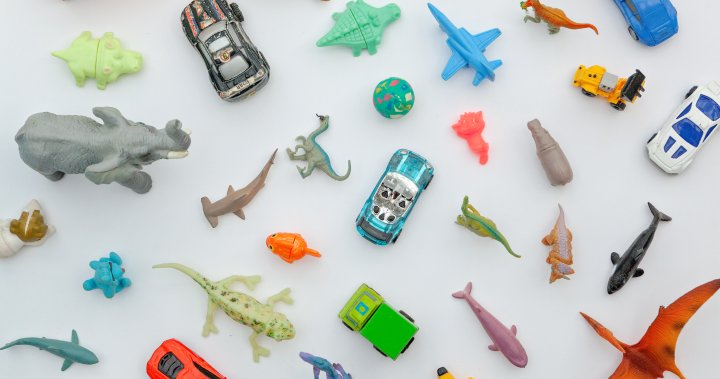Cancer-causing chemicals are lurking in household electronics and children’s toys, despite being banned for more than a decade in Canada, a study out of the University of Toronto found.
The study, published Tuesday in Environmental Science: Processes & Impacts, says chlorinated paraffins were found in more than 87 per cent of tested household products, which ranged from baby rattles, toy cars, hand soap and headphones.
“We found quite high concentrations of these compounds in toys meant for children and toddlers, in particular, teething toys,” said Steven Kutarna, the study’s lead author and PhD candidate in Analytical Environmental Chemistry at the University of Toronto.
Another “surprising” product that was found to contain one of the highest concentrations of chlorinated paraffins was earbud wires, he said.
Canada banned the manufacturing, sale, use and import of chlorinated paraffins in 2013, under the Canadian Environmental Protection Act (CEPA), as the chemicals were found to be dangerous.
The short-chain chlorinated paraffin (SCCP) toxin is not only a concern for the environment, according to Health Canada it is a “potential concern” for human health as “it was found to cause cancer in some experiments with laboratory animals.”
In an email to Global News on Tuesday, Health Canada said it is reviewing the U of T study “and will take appropriate actions, as required, to further protect the health of Canadians from potential effects associated with SCCPs.”
What are chlorinated paraffins?
All chlorinated paraffins are categorized as “toxic” chemicals under the CEPA.
They are typically used in metalworking fluids, paints, sealants, rubber and flame retardants in plastics, explained Karl Jobst, assistant professor in the Department of Chemistry at Memorial University of Newfoundland and Labrador.
They are used in everyday household items as well, mainly for their flame-retardant properties.
However, because of environmental and human harm brought on by chlorinated paraffins, there are a lot of other alternatives to the chemical, he added.
“Why we’re still seeing them in high concentrations is a little bit of a mystery to me,” Jobst said.
Evidence of the chemicals’ toxicity has been mounting over the years. Studies have shown the chemicals can accumulate in human breast milk, can kill small aquatic creatures and have been shown to have endocrine-disrupting properties.
The chemicals have been banned in Canada since 2013, and in 2017, SCCPs were listed for elimination under the Stockholm Convention on Persistent Organic Pollutants, which Canada is part of.

Although there are no human studies on their effects, SCCPs can cause cancer in laboratory rats and mice, specifically damaging the liver, thyroid and kidney. The International Agency for Research on Cancer recognizes the chemical as a possible carcinogen in humans.
“One of the most concerning properties of these compounds is their persistence and their potential to bioaccumulate,” Jobst said. “It’s not like you’re exposed to this once and then it goes away. These chemicals don’t degrade readily in the environment.”
Once a person has consumed this chemical, either through inhalation of dust or hand-to-mouth contact with electronics, they can remain in the blood for many years, causing harmful effects over time, he added.
Chemical found in baby chew toys
The researchers of the study looked at 96 indoor products including electric devices, toys, personal care products and indoor furniture. The products were either purchased in Toronto or collected from homes in the city. All items were newly purchased in 2019 or at least one year after the 2013 ban on SCCPs in Canada.
After analyzing the items, the researchers detected SCCPs in 84 of all the 96 samples.
Many products, like skin creams and shampoos, only had trace amounts, but others had enormous quantities of the chemical, Kutarna said.
“Especially in the electronics, we were finding them as high as one per cent by weight,” he said. “And one per cent is an absolutely enormous amount. It should not even be close that high.”
In terms of the toys that were tested, Kutrana said a majority of them were bought at Dollarama and the researchers found SCCPs in most of the products.
More on Health
The highest concentrations of SCCPs were detected in a foam toy.
“It was just a little squeeze toy … one of the ones just like a little red ball with a face on it,” he explained.
The chemical was also detected in toy packaging at relatively high concentrations.
He added that although many of the toys were bought at Dollarama, the products were imported from countries like China and Taiwan, so it wouldn’t be surprising if other stores had similar chemicals in their products.
“Product compliance is Dollarama’s utmost priority, and we have strict processes and controls in place to monitor product safety and quality,” a Dollorama spokesperson said in an emailed statement to Global News when asked about the study’s findings.
“We adhere to, and are held to, the very same standards as all other Canadian retailers, as are our products, many of which come from the very same sources as those sold by other major national retailers.”
The company added that it is “focused on increasing testing” to help get rid of certain chemicals in its plastic products, such as short-chain chlorinated paraffins.
Other products that had high amounts of the chemical in them included the outer plastic sheath of a computer wire and the outer plastic coating of an earphone wire.
After examining these products, the researchers found the concentrations of chlorinated paraffins in the items were 1,000 times higher than those SCCPs measured in Canadian indoor dust, “suggesting that they could be important indoor sources,” the study noted.

“This type of usage, particularly in headphone cables, provides opportunities for human exposure directly through hand contact with the cables,” the study added.
Using flame retardant chemicals, like chlorinated paraffins, in electrical wirings “makes sense,” Jobst said. However, he said he was “quite surprised” at the concentrations found in children’s toys.
How are banned SCCPs still around?
Although chlorinated paraffins are illegal in Canada, Kutrana said it can be a technical challenge to detect them, which is why they still show up in household items.
The problem, he believes, may lie with the supply chain.
“It may be that the manufacturers that are making the toys are getting their plastic from someone else that is including them in the mixture,” he said.
“The companies that are actually putting the toys on shelves aren’t able to trace all the way back to where the original source of the plastic came from.”
A 2011 study conducted for Environment Canada concluded that there are no imports of products containing SCCPs from the United States or Europe, according to the CEPA.
Read more:
UBC engineers find permanent solution for removing ‘forever chemicals’ from drinking water
CEPA also said that, while products containing the chemical may be imported from other regions of the world, none of these imports has been reported to Environment Canada.
“As a result, imports from these regions are expected to be small. Therefore, imports of products containing these substances are expected to be negligible under the status quo,” CEPA states.
While Canada has legislative controls in place, the presence of chlorinated paraffins in products clearly shows the challenge of ensuring compliance, which requires ongoing product testing followed by punitive action, the researchers of the study concluded.
Although there may be technical challenges in place when testing for chlorinated paraffins, Kutrana hopes technology for detecting these chemicals improves and that there is additional regulation for the government side.



